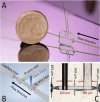A Microfluidic Device to Realize Electrochemically Controlled SERS Detection in HPLC
- PMID: 40545866
- PMCID: PMC12224159
- DOI: 10.1021/acs.analchem.5c02232
A Microfluidic Device to Realize Electrochemically Controlled SERS Detection in HPLC
Abstract
Surface-enhanced Raman spectroscopy (SERS) is a powerful technique for vibrational spectroscopy, but analyzing mixtures in solution remains challenging due to spectral overlap. Integrating SERS with a separation method, such as high-performance liquid chromatography (HPLC), offers a promising solution. However, online coupling has been limited by the compatibility issues between the SERS process and flow-based systems, which can result in either irreversible analyte adsorption on the SERS substrate or insufficient interaction. This can lead to signal carry-over or low sensitivity. In this study, we present the first HPLC-compatible, pressure-stable SERS flow cell designed for real-time analysis under continuous flow. Fabricated entirely from glass using selective laser etching, the monolithic flow cell incorporates a silver-based SERS substrate and a counter electrode, enabling online electrochemical SERS (EC-SERS) experiments. Electrochemical control facilitates on-demand substrate activation, thereby enhancing signal intensity, extending substrate lifetime, and eliminating memory effects. This approach broadens the range of detectable analytes, including those that are traditionally difficult to detect using passive SERS. We demonstrate the performance of the system through HPLC-SERS analyses of model dyes (e.g., crystal violet, malachite green, and rhodamine) and pharmaceutical compounds (e.g., cyanocobalamin and folic acid). This innovation introduces a novel SERS-based HPLC detection method, supporting the seamless integration of SERS into high-throughput analytical workflows.
Figures






Similar articles
-
Signs and symptoms to determine if a patient presenting in primary care or hospital outpatient settings has COVID-19.Cochrane Database Syst Rev. 2022 May 20;5(5):CD013665. doi: 10.1002/14651858.CD013665.pub3. Cochrane Database Syst Rev. 2022. PMID: 35593186 Free PMC article.
-
A Monolith-Based μHPLC-SERS Integrated Microplatform Featuring Mg2+-Regulated Dual-Capture Mechanism for Real-Time Online ATP Monitoring.Anal Chem. 2025 Jul 22;97(28):15153-15163. doi: 10.1021/acs.analchem.5c01444. Epub 2025 Jul 11. Anal Chem. 2025. PMID: 40643313
-
Electronic cigarettes for smoking cessation.Cochrane Database Syst Rev. 2022 Nov 17;11(11):CD010216. doi: 10.1002/14651858.CD010216.pub7. Cochrane Database Syst Rev. 2022. Update in: Cochrane Database Syst Rev. 2024 Jan 8;1:CD010216. doi: 10.1002/14651858.CD010216.pub8. PMID: 36384212 Free PMC article. Updated.
-
Ambulatory Oxygen for Pulmonary Fibrosis (OxyPuF): a randomised controlled trial and acceptability study.Health Technol Assess. 2025 Jul 2:1-33. doi: 10.3310/TWKS4194. Online ahead of print. Health Technol Assess. 2025. PMID: 40613728 Free PMC article.
-
MOF-Assisted Nanocellulose Paper-Based Platform for Multiple Surface-Enhanced Raman Scattering Detection.Anal Chem. 2025 Aug 22. doi: 10.1021/acs.analchem.5c02659. Online ahead of print. Anal Chem. 2025. PMID: 40844423
References
-
- Han X. X., Rodriguez R. S., Haynes C. L., Ozaki Y., Zhao B.. Surface-enhanced Raman spectroscopy. Nat. Rev. Methods Primers. 2021;1:87. doi: 10.1038/s43586-021-00083-6. - DOI
-
- Li C., Huang Y., Li X., Zhang Y., Chen Q., Ye Z., Alqarni Z., Bell S. E. J., Xu Y.. J. Mater. Chem. C. 2021;9:11517. doi: 10.1039/D1TC02134F. - DOI
LinkOut - more resources
Full Text Sources
Miscellaneous

